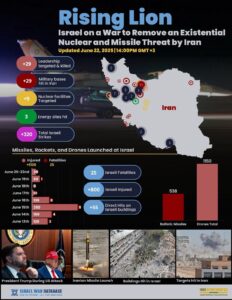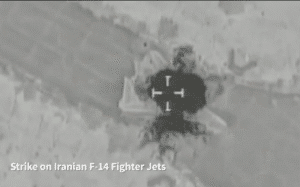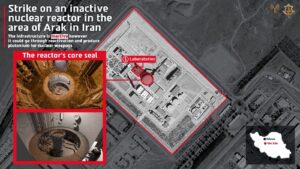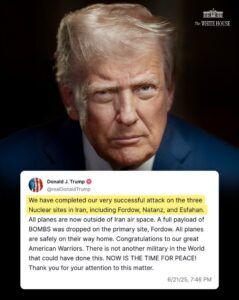Situation Report | “Rising Lion” – The Israel-Iran War
Day 10 | Updated June 22nd, 2025 14:00 PM (Israeli Standard Time GMT+3)
Operational Clock War: Starting +251Hrs.
For real-time updates, click here
Earlier versions of this report can be found here

Be advised, today’s issue includes a short-term analysis due to the situation
Military Developments
U.S. Strike on Nuclear Facilities
The U.S. targeted:
- Fordow: A uranium enrichment facility buried 80–90 meters underground in mountainous terrain, designed for deep protection.
- Natanz: Iran’s primary uranium enrichment site, featuring both above-ground structures and underground bunkers housing centrifuges.
- Isfahan: A major nuclear research complex with uranium storage capabilities.
Significance of the targets
- Fordow was Iran’s most fortified site, central to high-level uranium enrichment (up to 60% purity), raising proliferation concerns.
- Natanz housed thousands of centrifuges for uranium enrichment, critical to Iran’s nuclear ambitions.
- Isfahan served as a research hub supporting uranium conversion and fuel production.
Collectively, these sites formed the backbone of Iran’s nuclear infrastructure, with Fordow being deemed “virtually impenetrable” prior to the strikes.
Attack methods
- Aerial bombardment: 6 B-2 Spirit stealth bombers deployed using 12 GBU-57 Massive Ordnance Penetrator (MOP) “bunker buster” bombs (30,000 lbs. each) against Fordow. These munitions are designed to penetrate reinforced underground facilities. 1 B-2 also dropped two bunker busters on the Natanz site.
- Naval involvement: U.S. Navy submarines launched 30 Tomahawk Land Attack Missiles (TLAMs) at Natanz and Isfahan, targeting above-ground structures and secondary facilities.
Israel’s preparatory actions: Israel’s week-long campaign preceding the U.S. strikes significantly degraded Iran’s defenses:
- Air defense suppression: according to intelligence assessment, Israeli strikes destroyed over 50% of Iran’s missile launchers and radar systems, crippling air defense capabilities.
- Natanz: Israeli airstrikes on the Natanz nuclear facility that destroyed its electrical infrastructure, including the main power supply and backup generators, destroying critical infrastructure and forcing relocation of materials.
- Strategic weakening: By neutralizing key command facilities and forcing resource dispersion, Israel created vulnerabilities the U.S. exploited for precision strikes.
Israeli Operations
- June 21st: IDF conducted a new wave of strikes in southwest Iran, with 30 fighter jets dropping 50 munitions on dozens of Iranian military targets in the Ahvaz area. Among the targets was a facility for ballistic missile launchers.
- Airstrikes over storage facilities located at an Iranian naval base in Bandar Abbas, a strategic port on the Persian Gulf. The IRGC claimed that the Israel Air Forcewas targeting Iranian warships docked at the southern port.
- Over the first eight days of the operation, the IDF Spokesperson issued a press release stating that the IDF had carried out more than 1,000 strikes over Iran, dropping hundreds of munitions on Iranian ballistic missile launch and storage sites. The IDF estimates that over 200 ballistic missile launchers have been destroyed – about half of Iran’s pre-war arsenal.
- Attacks included Tehran’s police HQ, the Foreign Ministry, Internal Security HQ and the Imam Khomeini Mausoleum, a powerful symbol for the Iranian regime and Khomeinist ideology.
Elimination of officials
- Isar Tabatabai-Qamsheh, an Iranian nuclear scientist.
- Saeed Izadi, head of the Palestine Corps in the IRGC Quds Force and a key figure in arming and funding Hamas before the October 7 attack, were killed in separate Israeli airstrikes.
Iranian Attacks
- June 22nd: A large barrage of missiles, fired upon Israel by Iran, were mostly, successfully intercepted. Yet, there were 10 impact sites – direct hits and fragments, resulting in injuries to approximately 16 civilians. According to Mehr, Khyber missiles were used for the first time in this conflict.
- June 21st: A drone launched from Iran, struck a home in the northern Israeli city of Beit She’an on June 21, marking the first such direct hit on a civilian home since the conflict began.
- Following the strikes, Iran launched about 30 drones at Israel, all of which were intercepted by the Israeli Air Force and Navy, according to military sources.
Analysis
The US decision to directly attack offensively has sent shockwaves around the region and the world. Israel has been augmented by the strong backing from its primary ally, while Iran has found itself more isolated than ever. The European leaders who are negotiating with Tehran are stressing similar points to Israel and the US, and openly or tacitly have supported their actions. It is safe to assume that regional Arab countries are quietly pleased by this American involvement, after President Trump’s visit last month to the region which was mostly interpreted as limited to economic engagement, but turned out to be a major steppingstone to a strong military and political interest.
While Iran is mulling its retaliation, the region and the world are closely monitoring the situation. Iran’s dilemma revolves around preserving its national dignity and project the regime’s steadfastness, thereby retaliating against US targets in the region; and avoiding further escalation, risking the very foundations of the regime.
The next days will dictate the trajectory of this campaign, focusing on three key elements:
- The extent of damage to the core components of Iran’s nuclear program: sites, uranium stockpiles, and weaponization elements of the nuclear assembly line; and the damage inflicted to its ballistic missile project.
- The nature of Iran’s retaliation – whether it will continue to focus solely on Israel, or expand to US targets, or push its proxy cells, especially Hezbollah, to join the campaign. Iranian retaliation could also include a naval strike or disruption in the Strait of Hormuz, a critical chokepoint for global oil and gas shipments. Such an action could have immediate consequences on global energy markets, triggering price volatility and broader economic repercussions.
- Iran’s willingness to agree to the US and the E+3 terms on a possible long-term commitment to non-proliferation, with strong international supervision mechanisms.
Geopolitical Reactions
U.S.A.
- On Sunday, June 22, S. President Donald Trump announced a “successful attack” on Iran’s Fordow, Natanz, and Isfahan nuclear sites. In a televised address from the White House he stated:
“Our objective was the destruction of Iran’s nuclear enrichment capacity and a stop to the nuclear threat posed by the world’s number one state sponsor of terror. … Tonight, I can report to the world that the strikes were a spectacular military success. Iran’s key nuclear enrichment facilities have been completely and totally obliterated.”
Israel
- Prime Minister Benjamin Netanyahu publicly praised the American strikes, saying: “President Trump and I often say peace through strength. First comes strength, then comes peace. And tonight, President Trump and the United States acted with a lot of strength.”
- In response to heightened risk, the IDF Home Front Command announced the strictest civilian restrictions since the beginning of the Iran conflict.
Iran
- Foreign Minister Abbas Araghchi posted on X (Twitter) that the U.S. strikes had “blown up any possibility of diplomacy” with the U.S. or Europe.
- A senior Iranian official labeled European nuclear proposals “unrealistic” following talks in Geneva about Iran’s nuclear program
UK
- Prime Minister Keir Starmer urged Iran to re-engage in nuclear talks and pressed for a diplomatic solution to the growing regional crisis.
Germany
- Chancellor Friedrich Merz called on Iran to start nuclear negotiations with Israel and the United States.
France
- President Macron: “It’s absolutely essential to prioritise a return to substantial negotiations, including nuclear negotiations to move towards zero [uranium] enrichment, ballistic negotiations to limit Iran’s activities and capabilities, and the financing of all terrorist groups and destabilization of the region that Iran has been carrying out for several years”.
Qatar
- Urged de-escalation and diplomacy, warning of “serious regional repercussions.”
Oman
- Which had been mediating between Washington and Tehran, strongly condemned the U.S. strikes on Iran’s nuclear sites.
International Atomic Energy Agency (IAEA)
- Rafael Grossi, Director General, announced he will convene an emergency meeting of the Board of Governors to address the aftermath of the strikes.

The IAF struck F-14 fighter jets belonging to the Iranian Armed Forced in central Iran | Credit: IDF spokesperson

Prime Minister Netanyahu’s statement apprising President Trump for the attack | Credit: GPO, Prime Minister of Israel on X

President Trump’s Truth Social post announcing the attacks on Iranian nuclear site | Credit: The White House on X
